Temple Sinai in Morocco 2019
01/15/2019 09:53:02 AM
Temple Sinai members are in Morocco with Rabbi Ron Segal. Follow their journey on this blog and through our Facebook photo album here.
Casablanca and Rabat – Day 1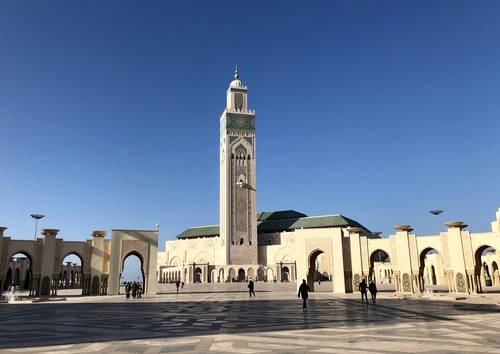
After more than a year’s worth of planning, we are finally all here in Casablanca! Everyone who has ever been to Morocco has only built the shared level of anticipation, raving about the sights, smells, and scenery. We started our tour in Casablanca on an exquisitely beautiful day. First stop was the Jewish Museum of Morocco – the only Jewish museum in an Arab country in the world. This fact should not be overlooked, as it speaks to Morocco’s commitment to honoring its Judaic (and Christian) past, as well as its welcoming nature to people of all backgrounds. The Museum featured photos and ritual objects from mellahs (neighborhoods where Jews lived), old synagogues, cemeteries, and ritual objects which have been preserved.
The population of Morocco today is @ 33 million (Casablanca is @ 10%). 99+% of the population is Arab (Sunni Muslim, Berber) with Bahai, Christians, and Jews comprising the rest. Prior to 1948, there were @ 250K-300K Jews in Morocco, 100K of which lived in Casablanca. Most found there way here a result of the Spanish Inquisition at the end of the 15th century. With the establishment of the State of Israel in ’48, Jews left en masse. The vast majority immigrated to Israel and it’s estimated there are only 2K-3K Jews left in Morocco today. As to why all of the Jews left a country where they were reportedly treated well, explanations vary, but for some locals it remains a mystery. Still, there is a firm commitment to their past, and in 2011, the King (Mohammed VI) modified the constitution to ensure that the country always honors the many cultures and ethnicities which have shaped Morocco’s society and diversity. Jewishly, this means that several synagogues are now preserved, overseen primarily as museums, and that Arabs in the markets will gladly point out where the mellah (Jewish section) once existed. Our Israeli guide, Lior, also shared that here – in an Arab country – she is comfortable proclaiming “I am Jewish Israeli” (something she would not do in places such as Jordan or Egypt). The previous king, Hassan II, stated about Morocco: “The country is a tree whose roots are in Africa, its trunk in Morocco, the side branches in the Middle East, and its top foliage in Europe.”
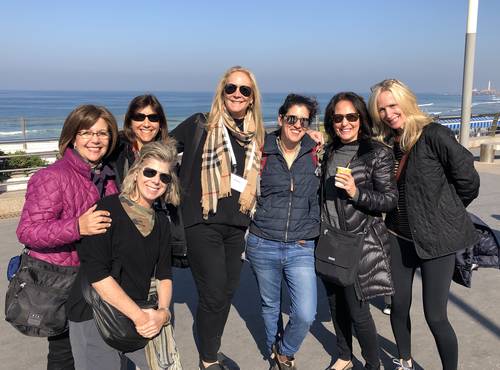 We stopped for lunch along the seawall, and then proceeded to the Mosque of King Hassan II. Built over 6 years, this mosque – the 2nd largest mosque in the world – opened in 1993 and was commissioned by King Hassan in order to help ensure Casablanca’s place of significance in Morocco and the Arab world. The mosque – which is absolutely stunning - can accommodate 105,000 worshippers at once (25K in the prayer hall, 80K in the outside plaza)! It also remains one of the only mosques in the world open to visitors and non-Muslims, and it not only incorporates exquisite craftsmanship and beautiful surfaces and materials, but also modern sensibilities and technology (e.g. hidden speakers throughout the grounds, a massive roof and 10 ton doors that open electronically, and more). It truly is incredible.
We stopped for lunch along the seawall, and then proceeded to the Mosque of King Hassan II. Built over 6 years, this mosque – the 2nd largest mosque in the world – opened in 1993 and was commissioned by King Hassan in order to help ensure Casablanca’s place of significance in Morocco and the Arab world. The mosque – which is absolutely stunning - can accommodate 105,000 worshippers at once (25K in the prayer hall, 80K in the outside plaza)! It also remains one of the only mosques in the world open to visitors and non-Muslims, and it not only incorporates exquisite craftsmanship and beautiful surfaces and materials, but also modern sensibilities and technology (e.g. hidden speakers throughout the grounds, a massive roof and 10 ton doors that open electronically, and more). It truly is incredible.
We then left Casablanca for Rabat, the capital city of Morocco. The first of the four designated “imperial cities” we will visit during our trip, Rabat - so named when the country was under French rule – is the second largest city in Morocco with 1.8 million people (only @ 100 remaining Jews in contrast with the 20K prior to WWII). We checked into La Tour Hassan Hotel – another visual “wow,” as architecture, tile mosaics, colors, and décor help to create stunning spaces, rooms, and outdoor gardens. Though disappointed that we are only here for one night, all have been reassured that the days ahead will be filled with one breathtaking site after another. Such was, in fact, the case when we arrived at Villa Sbihi, just over the river from Rabat, for our opening dinner. The first private home built outside the walls of the city 80+ years ago, the villa is owned by Ms. Riada Sbihi, who also served as our host for the evening. The beautiful grounds and traditional Moroccan style of the villa provided a most extraordinary setting. After dinner, Riada welcomed everyone to explore throughout the villa, including upstairs where she still resides, and she then even proceeded to unlock a few closets to show some of her magnificent, traditional Moroccan kaftans, each handmade for special occasions...an incredible treat.
After only one day, it is abundantly clear that the gracious hospitality we’ve already encountered will be a recurring experience throughout our time in Morocco. So….after a long incredible first day, I will simply say “Bon soir, Masa el kheir, Good night!”
Rabat and Meknes – Day 2
Our morning began with a visit to the Mausoleum which includes the tombs of King Mohamed V (d. 1961) and King Hassan II (d. 1999). The Mausoleum took a decade to complete, as every detail (tiles, carved stucco, mosaic, and more) is by hand. Quoting our guide, Lior: “King Mohamed V is to Morocco what David Ben Gurion is to Israel.” He oversaw Morocco’s independence following the French departure and he, his son King Hassan II, and now Mohamed VI have all worked to ensure warm relations with Jews, each honoring Morocco’s cultural, religious, and ethnic diversity. The Mausoleum is guarded by ceremonial guards known as Haras.
• Alawite Lineage – The kings cited above are part of the Alawites (Alaouite) dynasty and trace their bloodline to the Prophet Mohamed (aka – “sharifian”), founder of Islam; they – and all of Morocco - are Sunni Muslim. (Not to be confused with the Alawites of Syria who are followers of Ali (cousin of the Prophet Mohamed) and are all Shia Muslim.
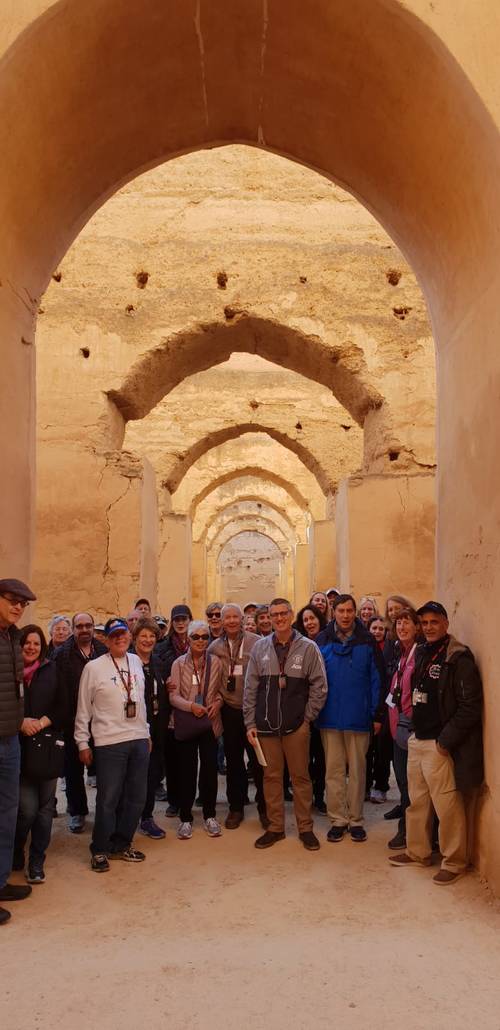 On the grounds outside the Mausoleum are structural pillars and a finished minaret for what was to be a great mosque, started in the 12th century by Yakob Mansour, leader of the Almohad dynasty. It was never completed due to his early death and a lack of power and resources by his successor. Soon after, another dynasty rose to power. The 900+ year old minaret, however, is used today for the Muslim call to prayer.
On the grounds outside the Mausoleum are structural pillars and a finished minaret for what was to be a great mosque, started in the 12th century by Yakob Mansour, leader of the Almohad dynasty. It was never completed due to his early death and a lack of power and resources by his successor. Soon after, another dynasty rose to power. The 900+ year old minaret, however, is used today for the Muslim call to prayer.
The final stop in Rabat -- the Kasbah (Arabic for “fortress) des Oudayas. Built in the 12th c by the Almohads, the large gates and walls are a clear indication of its original purpose as a fortress.
• History – 9th-12th c is considered the Golden Age for the Jews under Islamic rule. Jews were a protected class known as dhimmi. With rise of the Almohads, though, Jews and others were forced to convert to Islam or be massacred. Many, including the Rambam (Maimonides) fled Morocco south and east to more tolerant places. In many instances, Jews feigned conversion but continued their Judaism in private.
Since the end of the 15th c, though, the Kasbah has been a residential area, first settled by Berbers led by Oudayas. Following the Spanish Inquisition, the Kasbah was one of the places where Moors, Jews, and others also settled, bringing with them diverse ethnic practices, superstitions, cultures and more. Most visibly are the blue and white painted walls lining the narrow streets of the Kasbah, blue being both a color believed to protect against the evil eye in both Judaism and Islam.
After an hour+ drive, we arrived at our next stop - the city of Meknes. Situated near the base of the Middle Atlas Mountains, Meknes is in the middle of fertile plain and thus, King Moulay Ismail (17-18th c) named Meknes the capital (Meknes is the youngest of the four imperial cities). Meknes is the most fortified city in Morocco due to the focused efforts of Moulay Ismail (25 km of wall surrounding the Medina, massive royal stables for his 12K horses which also served as granaries, etc). Despite is brutality, much of what there is to see in Meknes today is the result of his reign (His story seems to mimic that of King Herod in Jerusalem).
After driving through a gate of the Medina (Medina is a term for a walled old city), we arrived at a large public square filled with vendors, people with animals offering rides, and more, adjacent to the beautiful Bab Mansour (the Gate of Mansour). After lunch, we went to the Mellah, the former Jewish neighborhood of Meknes. A mellach (Hebrew term for “salt”) is so named because so many Jews traded in salt. Historically, the mellach was always very near the royal palace, as the Jews were a protected class (dhimmi). We visited an old, run down Jewish cemetery where the former Chief Rabbi of Morocco – R. Rafael Berdugo – is buried. We met with one of the few remaining Jews in Meknes, Shalom Butbul and learned about his life. Today there are only 37 Jews remaining in Meknes, the youngest of whom is 60. Shalom remains so that he can continue to visit with Jewish tourists and help make a minyan on Shabbat (the only time it happens). 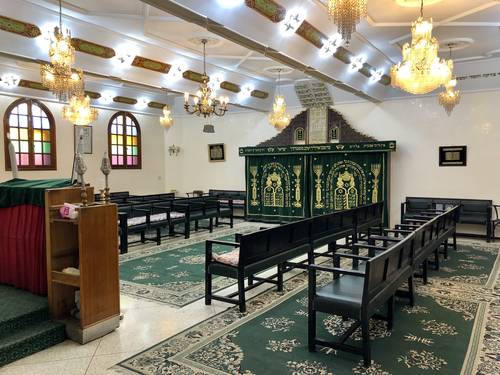
Fortunately, the Muslim family that cares for the one functioning synagogue in the new section of Meknes was available to open the building for us, so we were pleased to be able to add a visit to the synagogue, established in 1973.
A completely different experience followed the time in Meknes when we went to the 2nd-3rd century Roman city of Volubilis. Massive in scale (over 60 hectares), only half of Volubilis has been excavated to date, but the ancient ruins reflect many of the same features which characterized all large Roman cities of the time.
Finally, we are off to Fes where dinner is waiting and where we will be for two nights. An unbelievably full, but engaging and interesting day.
Fes – Day 3
The sights, sounds, smells, tastes… all of one’s senses are truly awakened in Fes! The medina (city) of Fes is the oldest in Morocco, dating to the 9th century, and the opportunity to spend the day learning its history, touring its various sections and alleyways (over 9400 in the original medina!), experiencing the unique and visual stimuli around every turn, and even doing a little shopping made for a most memorable and colorful day!
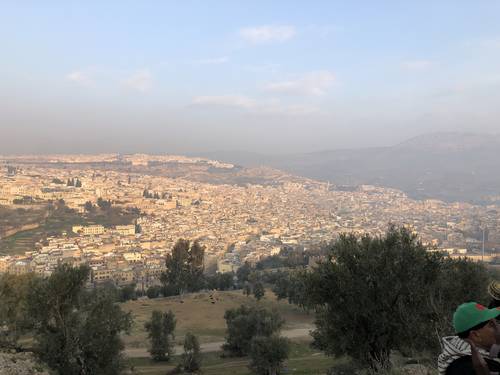
Unlike many countries in this region of the world, Morocco was never conquered by the Ottoman Empire. And, unlike cities such as Meknes, Rabat, and others, Fes was not built up by the Almohad Dynasty. Thus, entering one of the medina’s 24 gates truly enables a journey back in time. Fes has been a relatively peaceful city throughout its history and its population is a melting pot that reflects an historical blend of Berbers, Moors, Jews, Africans, and others who settled here over the centuries.
After an historical overview with a sweeping vista of “old” and “new” Fes, we then began our tour of the mellah, the ancient Jewish neighborhood. The Fes mellah is the oldest in Morocco, dating to the 14th century. Established by the Marinid Dynasty, the mellah was outside the walls of the medina, and the Jews in Fes were protected as dhimmi – a lower class of residents with strict guidelines regarding dress, profession, curfew, etc. The mellah itself was also surrounded by walls and had gates that were opened in the morning and locked at night – a reality that continued until 1912 and the beginning of the French protectorate. We first visited a beautifully restored Jewish cemetery in which are buried several sages and other individuals significant to Fes’ Jewish history (e.g. Rabbi Yehuda ben Atar, who issued new rulings and laws to lesson the economic burdens upon Jews living in poverty; Lala Solika, a 17 year old girl who chose to be die al kiddush hashem rather than convert to Islam; and Dunash ben Labrat, a writer and musician who infused Arabic/Moroccan tropes and sounds into Jewish music creating well known arrangements such as Dror Yikra). We wove through the small streets of the former mellah in what is known as Le Ville Nouvelle (the newer section of Fes) and visited two 17th c, beautifully restored synagogues. First was the Ibn Danan Synagogue, the oldest synagogue in Fes, established by the Danan family who came to Fes from Spain (the Danan family line remains influential in Moroccan life today). The other was the El Fassiyin (i.e. “of Fes”) Synagogue, established by local Jews in response to the Ibn Danan Synagogue just down the alleyway. And, located between the two synagogues is a sign above a small alley that reads “Chez Maimonides” and points one to a home in which Moses Maimonides (Rambam) lived during his five years in Fes (12th c). 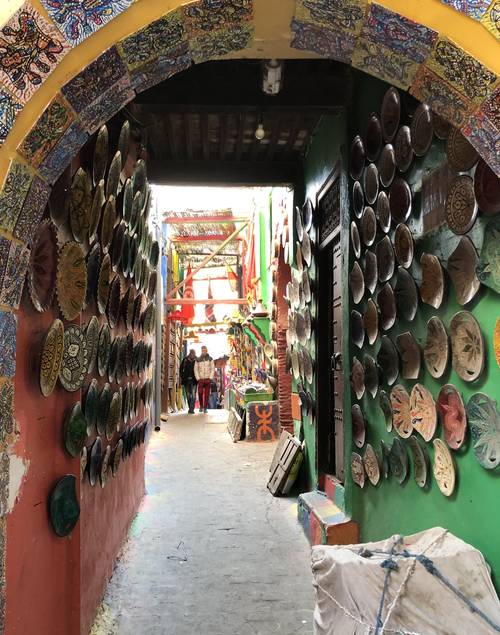
Jewish life in the mellah continued for centuries and Jews earned reputations as master silversmiths, coppersmiths, and traders (professions forbidden to Muslims). Life for Jews began to change in the early 20th c, however, with the growing influence of the French who began to send teachers to Morocco to begin educating the Jews of Fes – something not happening within the Moroccan Muslim community. Thus, when the French protectorate took control of Morocco in 1912 and Jews were soon to have equal rights and status, the Muslim residents of Fes attacked the mellah, breaking through gates and destroying homes and shops. The 1912 program left 60 murdered and 20K displaced Jewish residents, forced to relocate to a newer area of Fes where the population remained until 1948. Today it is estimated that there are only 37 remaining Jews in Fes.
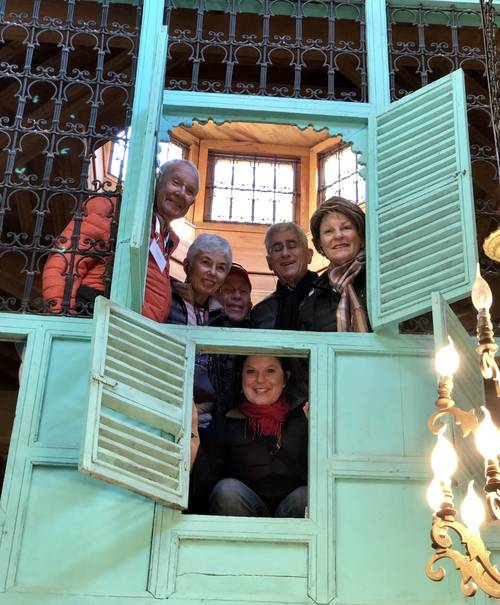 Following lunch at La Maison Bleue inside a beautiful Riad (a home with an internal garden & fountain that has become a guest house), we divided into smaller groups and spent the afternoon exploring the wonders of the medina. Led by Mohamed and two outstanding local Fes guides Khalid and Ahmed, we went to an exquisite madrasa (a non-religious boarding school that today serves as a mosque) and the colorful souk where we walked through alleyways and courtyards, each devoted to particular crafts: dyeing, copper vessels, weaving, etc. Fes is especially known for its quality leather products, so one particularly memorable - and pungent - stop was at the largest tannery in the medina, where countless vats of dye for leather are used to produce a vast array of leather goods in every color imaginable. A particularly humorous memory from our day will be the endless onslaught of aggressive vendors throughout the medina hawking their wares. Ask anyone on the trip how many wallets one can buy for 100 Dirham (Moroccan currency)! The final stop prior to dinner was at a ceramics workshop, another craft and skill for which Fes is known.
Following lunch at La Maison Bleue inside a beautiful Riad (a home with an internal garden & fountain that has become a guest house), we divided into smaller groups and spent the afternoon exploring the wonders of the medina. Led by Mohamed and two outstanding local Fes guides Khalid and Ahmed, we went to an exquisite madrasa (a non-religious boarding school that today serves as a mosque) and the colorful souk where we walked through alleyways and courtyards, each devoted to particular crafts: dyeing, copper vessels, weaving, etc. Fes is especially known for its quality leather products, so one particularly memorable - and pungent - stop was at the largest tannery in the medina, where countless vats of dye for leather are used to produce a vast array of leather goods in every color imaginable. A particularly humorous memory from our day will be the endless onslaught of aggressive vendors throughout the medina hawking their wares. Ask anyone on the trip how many wallets one can buy for 100 Dirham (Moroccan currency)! The final stop prior to dinner was at a ceramics workshop, another craft and skill for which Fes is known.
Our day in Fes was a sensory experience we will not forget.
Atlas Mountains and Into the Desert– Day 4
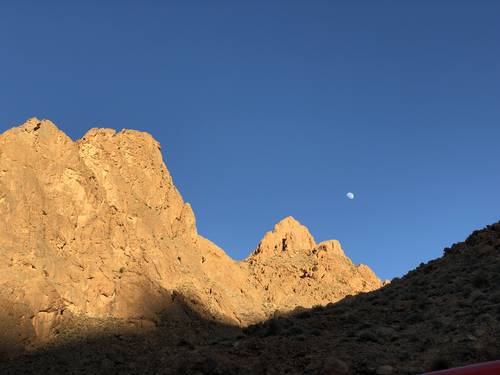
We left Fes @ 8:45 AM and arrived in Erfoud, our final destination, @ 7:45 PM. As the photos will show, there were certainly memorable stops and experiences along the way, but all told we were in transit almost 11 hours today, so this blog entry is going to be brief.
As the next few days of our journey take place in the desert, we had to climb into the Atlas Mountains, a 1700 mile mountain range which extends from southwest Africa, through Morocco, Algeria, Tunisia, and to the Mediterranean. As we drove higher in elevation, we eventually came to the city of Ifrane, a beautiful, affluent, Swiss-chalet designed town situated in the Middle Atlas Mountains that includes an expensive, private university (most education, including college, in Morocco is free), a ski resort, a nice park, and more. Ifrane is so distinct from anything we had seen (and unquestionably different than what we encountered not long after!) that it reminded me a bit of Helen, GA, albeit it much nicer.
One of our stops was in the Cedar Forest, home to Barbary Macaque Monkeys that tourists love to feed with fruits and nuts one can acquire on site. All was cute and adorable until one of the monkeys, without provocation, jumped at and bit one of our participants on the arm! Fortunately, the monkey’s teeth did not break the skin thanks to her jacket and clothing (though her arm still bled quite a bit).
Without question, the most incredible experience of the day took place when we made an impromptu stop in a small Berber town to walk through the market. Thursdays happen to be market days and Berbers from all the surrounding villages and rural areas come to the market where one can find anything imaginable – mattresses, furniture, food (fresh and non-perishable), rugs, clothing, spices, sundries, and more – all set out on tables in the open air for throngs of people from the region to buy. I have been to plenty of flea markets in my lifetime, but this was truly unlike anything I have experienced.
** Berbers are the indigenous people of Morocco and all of North Africa, dating back almost 4K years. Berbers comprise approximately 50% of the Moroccan population, and in addition to Arabic, they have their own language – Tamazight – which is comprised of many dialects. In 2011, Tamazight was added to Moroccan school curricula (as were Holocaust studies). Since the spread of Islam in the 7th century, all Berbers have identified as Muslim, and they are into all aspects and socio-economic levels of society (e.g. Of the Moroccans on our bus, two are Berber and one is an Arab Muslim). Berbers are people of their heritage and call themselves “the people of freedom.”
We continued climbing up and over the High Atlas Mountains, stopping one final time at the Ziz Gorge. The Ziz River is an important source of water for the date crops and industry which are a significant part of the Moroccan diet and social fabric. At long last, we arrived at our hotel where everyone ate dinner and readily called it a night. Tomorrow, we are headed into the desert!
Erfoud, Rissani, and the Merzouga Desert Camp – Day 5
“Soul-stirring.” If I were to try and summarize this day filled with continued special, unexpected, and unanticipated moments in one word, this would be it. Soul-stirring.
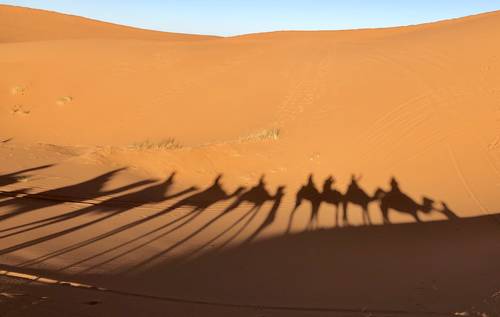 We departed our hotel in Erfoud and drove no more than 5 minutes before pulling over and exiting the bus to see what a Jewish cemetery and the lovely memorial shrine dedicated to Rabbi Shmuel Abuchatzera, one of the most important rabbis in Moroccan Jewish history, considered a tzaddik throughout the Chabad and Orthodox Jewish world. As Lior discussed his story, she noticed two additional men standing with us and listening, so she engaged them in conversation. Incredibly, one of the men - David Golan – is the person who gave the money (along with a few other families) to build the shrine and the adjacent synagogue (the other man was the local architect) – and we just happened to be there at the same time! Mr. Golan knows the rabbi’s son (who lives in Israel) and was born and raised in Erfoud until the age of 12, when his family moved to Israel. He built the special memorial and the inspiring worship space in order to honor his Moroccan heritage, as an expression of his faith and dedication, and to create a meaningful place where the 100K+! Jews who make pilgrimage each year for R. Abuchatzera’s Ilula (joyful celebration of a yahrzeit) can gather, honor a tzaddik, and pray. All agreed that the experience seemed b’shert.
We departed our hotel in Erfoud and drove no more than 5 minutes before pulling over and exiting the bus to see what a Jewish cemetery and the lovely memorial shrine dedicated to Rabbi Shmuel Abuchatzera, one of the most important rabbis in Moroccan Jewish history, considered a tzaddik throughout the Chabad and Orthodox Jewish world. As Lior discussed his story, she noticed two additional men standing with us and listening, so she engaged them in conversation. Incredibly, one of the men - David Golan – is the person who gave the money (along with a few other families) to build the shrine and the adjacent synagogue (the other man was the local architect) – and we just happened to be there at the same time! Mr. Golan knows the rabbi’s son (who lives in Israel) and was born and raised in Erfoud until the age of 12, when his family moved to Israel. He built the special memorial and the inspiring worship space in order to honor his Moroccan heritage, as an expression of his faith and dedication, and to create a meaningful place where the 100K+! Jews who make pilgrimage each year for R. Abuchatzera’s Ilula (joyful celebration of a yahrzeit) can gather, honor a tzaddik, and pray. All agreed that the experience seemed b’shert.
The next stop – a fossil stone plant -- was a few hundred feet away and was one of the day’s unanticipated surprises. Fossils dating back 300-500 million years have been found in slabs of earth and these workers and artists transform them into beautiful works of art as well as functional pieces for home. A few of our participants purchased some beautiful pieces.
We next came to the small Moroccan city of Rissani, particularly important because it is the birthplace of the ruling Alouite Dynasty. Kings Mohamed V, Hassan II, and now Mohamed VI trace their family lineage to Rissani, thus ample resources have been invested in certain parts of the city. Accompanied by a local guide (Hircham is in blue robes), we experienced both economic extremes. Through a majestic, guarded gate is a lovely mausoleum honoring the memory of Moulay Sharif, grandfather of Mohamed V. The manicured grounds, divided into four quadrants (representing the four seasons) with a central fountain (symbolic of an oasis) also featured a beautiful mosque. Only a few hundred feet away, though, we walked through a Ksar, a primitive and crude mud-brick, walled housing complex without running water or electricity. Skylights illuminate some of the narrow walkways with doors – some old, some new – into small “homes” (think ‘apartments’) that could include as many as 14-18 people. Hircham and his large family (almost 20) are one of approximately 65 multi-generation families living in the Ksar.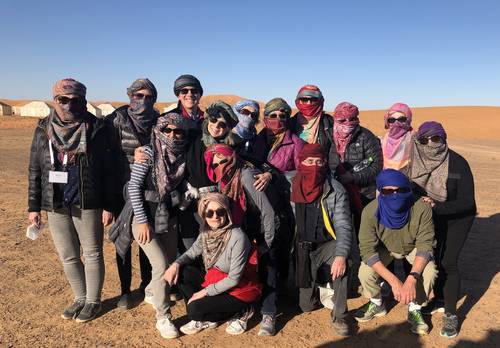
After a “questionable” lunch in Rissani, it was onto the jeeps (i.e. small 4 x 4s), that drove us -- on and off the roads -- for @ an hour to bring us to camels that were waiting to take all who wanted to ride to our Merzouga desert camp for the rest of the evening. The Sahara desert is majestic and awesome in the truest sense of the word; in just minutes, it was clear to see how one could easily get lost in the Sahara. We finally arrived at our Berber camp, greeted by live Gnawa music (origin: Ghana) and waiting snacks, and then everyone claimed a tent. As accompanying photos will show, the desert camp setting is exquisite, and the Berbers who run the camps could not be more hospitable. The tents themselves are comfortably appointed with a private bathroom and a “heater” that, we all concluded, is only for appearance 😊. Advice - The next time you are traveling and someone warns you that desert temperatures drop dramatically at night, believe them - It was easily in the 30s inside our tents
overnight! Despite feeling like a human popsicle in the morning, everyone was a great sport. The overall experience – which included a brief Shabbat service under the stars, an amazing traditional meal, live music and dancing by local performers, and even some gentle singing by a bonfire for those who stayed up a bit longer led by Lior on guitar – combined to create a magical and memorable experience!
The Atlas Mountains, Brief history of Jewish Emigration from Morocco – Day 6
People emerged “a bit chilly” from their tents this morning, some having even slept with ski hats, coats and gloves beneath the thick wool blankets. We converged upon a dune near the main gathering space, where one of the Berber hosts quickly built a bonfire, so we could watch a beautiful sunrise. Following breakfast in the tent (where people continued to thaw), we rode jeeps to a higher elevation dune for some sand-surfing and using either a snowboard or boogie board, those who wanted took a run. The most difficult part? Climbing back up the sand dune!
With the sun high in the sky, we boarded the 4x4s for the ride back to our bus and the journey westward through the Atlas Mountains. The importance of an oasis in a desert region needs no explanation, so it is not hard to understand why the 20 mile long oasis of Tineghir gave rise to a village and even a lovely French restaurant (Chez Michelle) where we stopped for lunch. We then began an ascent into one of mountains in order to see the Todra Gorge, a popular destination for tourists and rock/mountain climbers alike. The dramatic cliffs tower over a boarded-up hotel built in the gorge years ago; it closed when a large boulder fell from the cliff through the roof and into the kitchen of the hotel!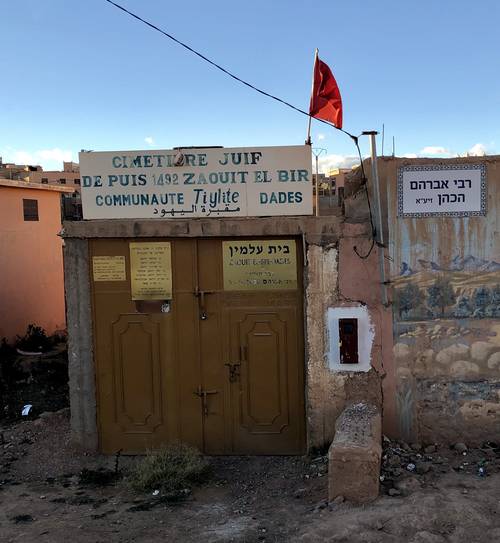
With several more hours of transit to go, we continued the journey west, passing landscapes with countless Kasbahs (private fortresses) en route. Along the way, we had the opportunity to learn more about the Berber people, Moroccan government, women’s rights, and the brief Summary of the Jewish emigration from Morocco.
> Until the 1950s, approximately 10K Jews lived in the region of the Atlas Mountains. Their connection to civilization was through rabbis from larger cities like Marrakech.
> Like other Arab nations, Moroccans were not happy with the establishment of Israel in 1948 and the French were pressured to limit Jewish emigration. Until 1956 and the end of the French Protectorate, only 18K Jews immigrated to Israel. Once independent, King Mohamed V, as head of a newly independent Arab country, could also not be seen to support Israel so, he also closed the emigration of Jews.
o The UJA sent an Israeli delegation in 1952 to study the Jews of the Atlas Mtns.
> From 1956-1961, with Israel’s assistance, approximately 100K Jews left Morocco through underground approaches, most secreting out of the country at night in boats. Some were motivated by Zionist aspirations, some (like the family of Lior’s wife Keren), fled from small villages at the threat of Arab violence against them.
> 1961 – a boat carrying 44 Moroccan Jews sank and all the passengers drowned. The event gained international attention and brought the desire of Moroccan Jews to immigrate to Israel to the surface. Ultimately, Israel reached an agreement with the King - $250 would be paid for every Jew allowed to leave. Between 1961-1968, another 100K Jews left.
> By 1968, there were approximately 30K Jews remaining in the country, who also continued to dwindle over the decades. Today, it is believed that there are only 3K Jews left in Morocco.
After last night’s overnight adventure, everyone was thrilled to arrive at the fabulous Berbere Palace Hotel in Ouarzazate (pronounced “whar-za-zaht”). Masa el kheir! (“Good night!” in Arabic)
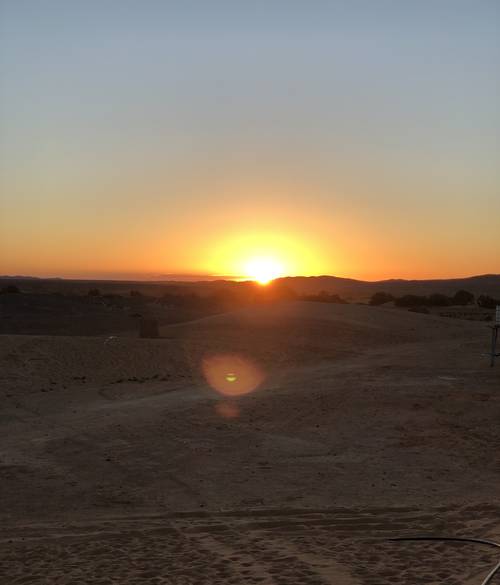
From Ouarzazate to Marrakech – Day 7
The Berbere Palace Hotel in Ouarzazate (“whar-za-zat”) where we stayed last night was apparently one of the top rated hotels in the world last year! Unfortunately, we only had about 14 hours to enjoy it before setting out again this morning. Ouarzazate’s ability to support a hotel of this caliber is due in large part to the success of the film industry. Movies such as Lawrence of Arabia, Babel, and Gladiators were all filmed in the vicinity; the photos show one of the three major studios – CLA Studios – which we passed en route to our first stop. Eit Ben Haddou is a UNESCO World Heritage site that was once a bustling Ksar (fortified city) that also included a mellah, but today houses only 10 families as its conditions have deteriorated. Eit Ben Haddou also serves a site for movie scenes.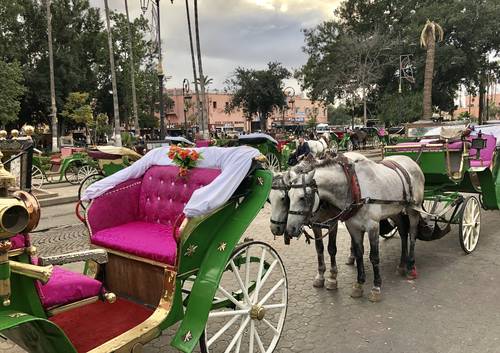
The drive to Marrakech from Ourzazate is not for the faint of heart, as it requires driving over the High Atlas Mountains on traveling on a winding two lane road that torn up in places, exceptionally narrow in others, and which even had to navigate droves of pedestrians as we passed through a small village with an active outdoor market (see video). Our driver Mustafa definitely earned the round of applause he received.
• Along the way, we learned a bit more about the Moroccan Jewish immigration to Israel and the manner in which they were dropped - in the middle of the night - in a field in Kiryat Gat (in the Negev) with nothing but the tent they were given and minor provisions. Written accounts of the experience paint an emotional and traumatic picture of what it must have been like for those early families who, essentially, were duped into thinking they were joining relatives elsewhere in the country.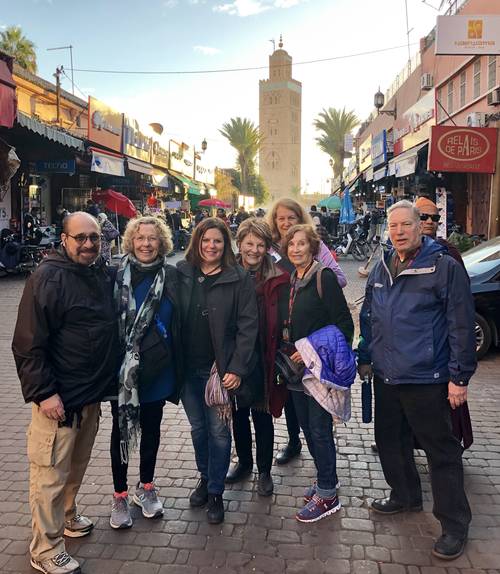
We arrived in Marrakech in time to check into our spectacular Riad (characterized by a center garden open to the sky with rooms surrounding it) - La Maison Arabe (one photo is of our room). Marrakech is the second oldest of the four imperial cities (after Fes); the Koutoubia Minaret – the tallest structure in the city – dates to the 12th c. The Medina of Marrakech is immense and includes our Riad, the minaret, the famous giant square - Djemaa el Fna – with its snake charmers, fortune tellers, “watermen” (photo of man in red), male belly dancers (considered improper for women to dance in public), musicians performing music from different regions in the country, and the largest open air food market in the world. It is a visual spectacle that words do not do justice, but hopefully the brief video can provide a small glimpse into the square.
The Medina did, of course, once include a large mellah that, at one time, had up to 35 different synagogues and a Jewish population of almost 30K. Today, there is one active synagogue in the area of the mellah and one in the new part of the city (more tomorrow).
People were on their own for dinner this evening and then everyone called it a night after another memorable day.
Marrakech – Day 8
It is a joy to wake up and know that we get to stay put for one more day, especially in a place as spectacular as our Riad…
The morning began with a visit to Jardin Majorelle (Majorelle Gardens), a truly magnificent garden first envisioned and established by French painter Jacques Majorelle, who opened the garden to the public in 1947. The gardens were acquired by Yves Saint Laurent and Pierre Berge’ in 1980 and were donated to the country upon YSL’s death in 2008.
The balance of the morning focused on Jewish life in Marrakech, past and present. Once a community of 20K, the Jewish community numbers @ 200 people today. We went to Congregation Beth El, one of two active synagogues in Marrakech, and met with Mr. Jacky Kadoch, the leader of the congregation and also the President of the Moroccan Jewish Community. Beth El was established in 1958, two years after Morocco’s independence, in an area of Marrakech previously prohibited to Jews. and when Jews were finally The congregation holds Shacharit and Shabbat services.He spoke frankly about the sobering demographic reality of Jewish life in Morocco. “We are almost the end. In 5 years, there will be no Jews left in any of the small cities and rural villages throughout the country, and in Casablanca (1K Jews today), the Jewish community will be gone in a few decades.” Mr. Kadoch is actively preparing for that time by ensuring that “our grandchildren” will know and be able to learn about the Jewish life that was here – arranging for synagogues to be maintained as museums, educational materials, guidebooks and other resources about the story of the Jews in Morocco to be prepared and available for visitors.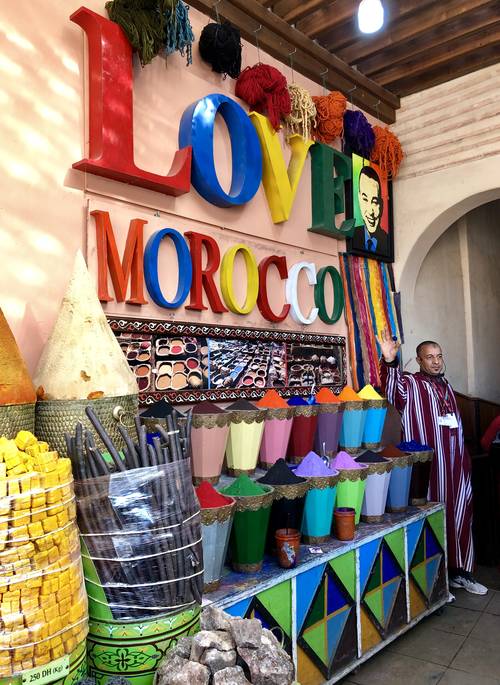
After leaving Beth El, we toured what was formerly the mellah (the Jewish section of the medina) and came to the other active synagogue in Morocco - Slat el Azama (synagogue of the expelled). The congregation is almost 500 years old and was established by Jews who were expelled from Spain at the end of the 15th century. The synagogue itself is one of the spaces in a riad that also included a Talmud Torah (a place for serious study) and which now has filled most of its rooms with artifacts and photos. Like most other synagogues located in a former mellah, the keys and upkeep of Slat el Azama are in the care of a local Moroccan Muslim family…. soon to be the reality for every synagogue, Jewish museum, and Jewish site in the country. In light of the unavoidable future, it is heartening to see that King Mohamed VI is investing ample resources into the Marrakech and Casablanca – Our Last Day refurbishment of the mellah and surrounding areas.
The afternoon included a tour of the El Bahia Palace (Arabic for “the most beautiful”). Begun in the middle of the 19th c by Si Moussa (Grand Vizier to Sultan Hassan I) and completed at the end of the 19th century by his son Ahmed ben Moussa (aka Ba Ahmed) the El Bahia Palace is a cultural and architectural treasure. As the Stars of David present in the tile work reflect, the palace is also evidence of the religious tolerance in Morocco at the time. The palace is immense (more than 8 hectares), with only a portion now serving as a museum; the rest has been renovated and is used to house visiting dignitaries.
One of the top rated hotels in the world is La Mamounia where we visited for high tea in one section of the exquisite grounds. Originally a palace and gardens given by the King to his son at the end of the 18th century, the French decided to transform La Mamounia into a hotel in 1922.
Our final experience of the day was a Moroccan cooking class. At individual work stations, we each prepared our own dinner, including Chicken Tagine and side salads, that turned out to be delicious!
Marrakech has a special character which is distinct from every other place we’ve been. It’s clear to see why it remains a favorite destination for so many.
Marrakech and Casablanca – Our Last Day
Though some in the group began the day at the Yves St. Laurent Museum, for most, our remaining time in Marrakech was an opportunity to hit the souk (Arabic for market) and do some shopping. One of the local guides – Mohamed (VIII 😊) – escorted a group of us to the market and pointed out some of the nicer shops, beginning with a truly incredible, three floor, rug/carpet store (Palais Saadien) where several of us contributed to the Moroccan economy! Our small group of eight meandered through the countless alleyways and streets of the souk (others from the trip were doing the same), stopping to bargain and buy whenever something caught a person’s eye.
We reconvened at the hotel mid-afternoon and our time in Marrakech sadly came to an end as we began our return to Casablanca for our final night. En route, some chose to share a few highlights and/or special moments from the trip. The comments shared heaped ample and well-deserved praise upon our outstanding guides, Lior and Mohamed. And, after traveling together for 10 days, there was no shortage of particularly humorous moments as well. With apologies to those not on the trip, here are a few memories shared that should put a smile on participants’ fas:
-
The typhus infected bus (12 of our 36 participants were sick at one time or another)!
-
“Belak! Belak!” (Get out of the way!) – often heard in the markets/souks
-
The fake heaters at the Merzouga Desert Camp
-
Feeling like human popsicles
-
Mohamed VII, VIII,… IX? (We were introduced to a lot of Mohameds during the trip)
-
Leather Wallets in the Fes Souk – is it 6 or 7 for 200 dirham?
-
Mohamed’s jokes
-
Availability of toilet paper never a certainty
-
Moroccan potties
-
Monkeys that don’t like women
-
Dodging a nonstop barrage of motorbikes on the streets, in the souk alleyways, everywhere
We finally arrived in Casablanca and went to the restaurant for our closing dinner… Rick’s Café. In 2004, Kathy Kriger, z”l, left her position as an American diplomat and – out of her love and appreciation for Morocco - decided to create a restaurant modeled after the restaurant of “Casablanca” movie fame. It was a perfect place to dine for our final trip meal together. Early tomorrow, it’s off to the airport.
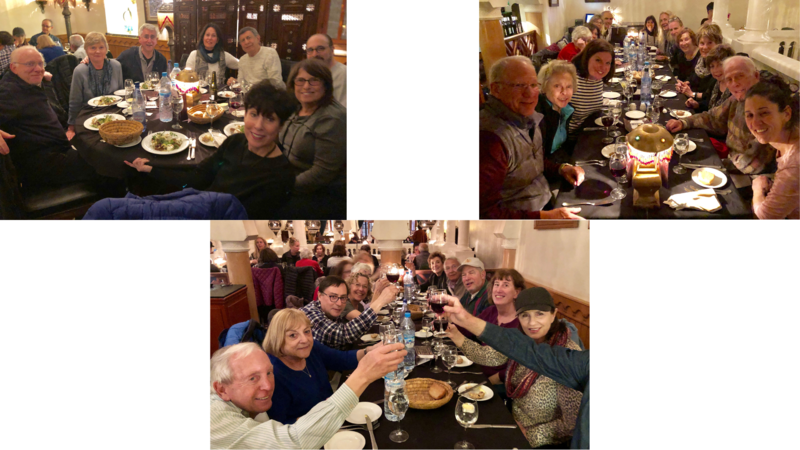
For any reading this blog who have not traveled to Morocco, I cannot encourage you strongly enough to add the country to your list! The story and history of Jews in Morocco is one that should be appreciated, and every region of the country offers a visual, cultural, and sensory feast for visitors, enhanced by the sincere hospitality, warmth, and kindness of the Moroccan people who are all incredibly proud of their country. And, as we had to keep reminding ourselves, we were in an Arab country! The tolerance and sense of welcome we experienced in Morocco are a beautiful reminder of what is possible when compassionate and capable leadership rule the day. It was a privilege to share some of our experiences over the past 9 days with readers.


